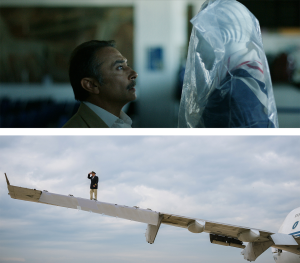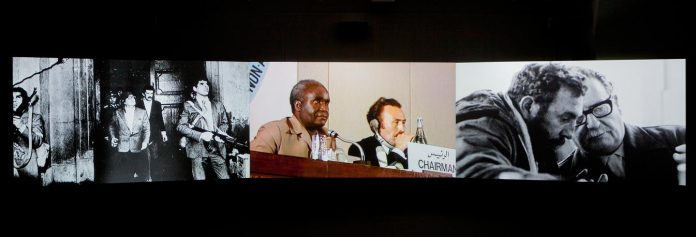(THIS ARTICLE IS MACHINE TRANSLATED by Google from Norwegian)
When the bombed-out small town of Kassel was to be rebuilt from the war hell, a local anti-fascist artist, returning home after war captivity, established a contemporary art festival for the art the Nazis had banned. No one in 1955 could dream that Documenta – which was then part of "The German Garden Exhibition" – would within a few decades become the world's most important art festival in most measurable terms, and that it would be visited by around a million people each once it takes place. Documenta is organized every five years and is compulsory for all artists, art students and others with ambitions to understand and participate in international contemporary art.
This year's Documenta 14 was pronounced politically and activist and was based on nationalism, migration and our close history.
Document 14. This year's exhibition was stated politically and activist, and curated by the leading, radical Polish curator Adam Szymczyk. He has based nationalism, migration and our close history to create an exhibition that breaks with the social and economic hierarchies of the art world. I therefore had expectations for this year's version – which was also arranged in Athens for the first time – although from experience I rarely get anything particularly out of political art within such a framework. I myself have participated in another major international exhibition, Manifesta, and have known how such contemporary art exhibitions can place restrictions on "politically engaged" art; they are heavily funded by public funds, and it does not have to provoke the granting authorities too much.
Documenta 14 is an extremely extensive exhibition consisting of traditional gallery rooms, film programs, publications, archives, performances and actions, debates, outdoor installations and concerts. It took three days, with opening hours from 10.00 p.m. 20.00 am to XNUMX pm, to experience it.
It is the experience of the exhibition's dynamics, the interaction between cultural and political statements and my physical and mental movement through the one that remains as the most thought provoking. As a socialist, it was gratifying to see truly radical contributions to class and identity discussions. Because, as an artist, I am primarily concerned with strong individual works, this time – unlike the earlier versions of Documenta I have seen – I was also pleasantly surprised at the uneven, but at its best, high level of ambition.
 Two Meetings and a Funeral. My personal favorite piece was Naeem Mohaiemen's video installation from 2017. Mohaiemen was born in London in 1969 by parents from the part of Pakistan that later became Bangladesh. Mohaiemen is known for working up against the left-wing radical movements of the past, and has dealt with Japanese red brigades, among others. He himself has been politically active for many years, including in the Visible Collective group which consisted of artists, activists and lawyers who worked against the suppression of the Muslim subclass in the US after 9/11. I also have a long time as a politically active person, and therefore often react negatively to artists who enter into political issues without having contact with the social movements and the historical preconditions for what they theme – it is often hollow, arbitrary and characterized by factual errors that shows that this is not digested material.
Two Meetings and a Funeral. My personal favorite piece was Naeem Mohaiemen's video installation from 2017. Mohaiemen was born in London in 1969 by parents from the part of Pakistan that later became Bangladesh. Mohaiemen is known for working up against the left-wing radical movements of the past, and has dealt with Japanese red brigades, among others. He himself has been politically active for many years, including in the Visible Collective group which consisted of artists, activists and lawyers who worked against the suppression of the Muslim subclass in the US after 9/11. I also have a long time as a politically active person, and therefore often react negatively to artists who enter into political issues without having contact with the social movements and the historical preconditions for what they theme – it is often hollow, arbitrary and characterized by factual errors that shows that this is not digested material.
Mohaiemen's Two Meetings and a Funeral is, on the other hand, an impressive piece of documentary work that convinces with its political insights, artistic sensitivity and formal qualities. As I sit in a dark room comfortably furnished with cinema chairs and carpets, the story slides in and the artist's points come out clearly in a three channel projection that provides a wide and wide picture area. Mohaiemen talks about how Bangladesh, after the bloody detachment from Pakistan, evolved from experimental socialism within the Alliance-Free Movement, to being forced into the conservative Organization of Islamic Cooperation under the US imperialist agenda during the Cold War.
It is ironic that the fight against Islamist forces has taken over the fight against the third way, because this Islamism is a real child of American imperialism.
It is a sad story, but it must be told not to be repeated. We are facing major global changes, and Mohaiemen's story of optimism in the then newly independent states, liberation movements and global solidarity is an important, albeit tragic, backdrop for today's international situation. Contrary to the dominant attitude in Western media and politics, US power management is no solution in Two Meetings and a Funeral. It is the very basis of the problems we are experiencing, and Mohaiemen's account not only seems likely – it seems true.
Important for the road ahead. Both Mohaiemen and I were small children when Chile's President Salvador Allende was killed in a 1973 CIA-backed coup – but it seems like an eternity since. This incident appears as a dark shift in a story that could have ended well, but instead ends with an empty shell of a building in Algeria – the conference building erected by young Algeria after the liberation war against France, the same building that was the site of The movement of alliance-free states meeting in 1973 with all its radical and solidarity statements. In this building, post-colonial statesmen from the Third World postal states waited for Allende, and then mourned the coup in Chile along with leaders of the liberation movements of the time – such as PLO's Yassir Arafat and the provisional revolutionary South Vietnamese government's Foreign Minister Madame Bin, who at times opened his press office Ladies and Gentlemen of the International press, please list ». Today the building is dilapidated and a reminder of what was lost. And in Bangladesh, a trade fair that once symbolized national independence and faith in the future is now left to commercial interests. There is nothing left of the dream of a third way, regardless of the imperialism of the superpowers, other than faded filming.
These footage, on the other hand, is important to understand how extreme the pressure of the United States and its allies Islamist states against the progressive movements was in the 70s and 80s, until what was left of the anti-imperialist power of the Third World disintegrated in the 90's. It is ironic that the fight against Islamist forces has taken over the fight against the third way, because this Islamism is a real child of American imperialism.
By understanding what happened to the progressive movements of the 70s and 80s, we become aware of the systematic and pervasive nature of oppression.
Hope through understanding. Mohaiemen has no clear alternatives for the road ahead, but in the meeting with radical artists and theorists we understand that there is hope that the experience of the experiments of the 60s and 70s was not in vain. By understanding how things could go so wrong, we become aware of the systematic and pervasive nature of oppression. If Norwegian politicians on the left were as clear-sighted as Mohaiemen, they would hardly have adopted Norwegian participation in the Libya war or sent soldiers to Afghanistan. Mohaiemen's film is so profound and compelling in its artistic gravity that it should have been compulsory for system critics; how can we discuss the path further without taking over what happened to the third path 40-50 years ago?


